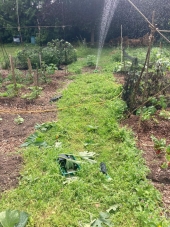how much cardboard are you talking and do you expect to ever remove the cardboard? cuzz the answer is unfortunately no. I have buttercups from 1 inch to 3 feet tall, cardboard doesn't stand a chance against the dormant rhizomes and generations of seed.
What does work but it's no instant gratification is solarizing the plants and soil with 1 summer under black plastic. Reveal in the fall to start germination of the seeds then cover for 1 winter, the next year you will have gotten ridden of 95% of it. Rodents will have a burrow fest under the waterlogged soil and in the spring you can create the type of garden or broad scale planting that's appropriate to your local conditions.
I had to get bees because I can't harvest enough of it for the ducks to make a dent in an acre, it makes good mulch or
compost fodder if you can mow it down and collect it mechanically but it's not worth it by hand. What I've found more effective is to cardboard it; cut chunks of it out and replace with compost and plant with potatoes. I noticed one year there was an empty spot in the buttercup coverage and when I checked it, potatoes planted from years ago had regrown multiple times in the same spot. The organic matter potatoes leave behind displaces the rhizomes which only dominate in unfavorable conditions. Where I had black plastic I planted
flax and potatoes bare soil and just walked away. In the next few weeks i'll start sowing peas and radishes into the die down, the key is not to harvest the potatoes but let them bulge the earth and then bring in the rodent highways that destroy the rhizome matte over the winter. They never get all the potatoes and the next year the potatoes return to build and dominate the soil. The radish and peas I want for there greens I leave as much roots in place as I can during a soil reconstitution phase. Buttercups really identify an oxygen problem in your soil, that plant doesn't drown.
















































